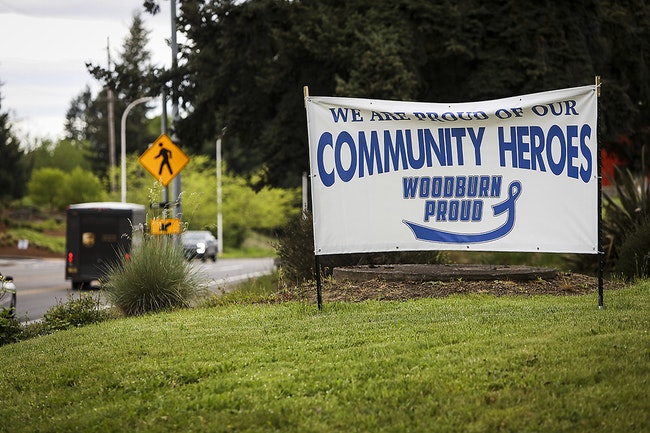 A sign at Salud Medical Center in Woodburn on Wednesday, April 29. (Amanda Loman/Salem Reporter)
A sign at Salud Medical Center in Woodburn on Wednesday, April 29. (Amanda Loman/Salem Reporter)
Latinos and residents of less affluent parts of Marion County have been the biggest local beneficiaries of a state program intended to help workers isolate themselves after exposure to Covid.
In September, the Oregon Department of Consumer and Business Services rolled out its Covid-19 Temporary Paid Leave Program, which was funded by federal pandemic relief money.
The program was set up to provide payments to workers whose jobs don’t have paid time off and didn’t fall under a new federal law mandating medical leave related to the pandemic. Workers who qualify get $120-per day payments up to 10 working days totaling $1,200 for the time they have to quarantine or isolate. To date, it’s paid $13 million to workers across the state.
Numbers provided by the department show that since the program began in September, $1.7 million has flown to workers in Marion County. Of the 1,744 Marion County workers who received payments, most of the money went to a handful of ZIP codes that include Woodburn, as well as north Salem and surrounding areas, which have lower incomes and higher Hispanic populations than the rest of Marion County.
Those areas have also been the hardest hit by Covid, according to county health department data. The Woodburn area is home to about 8% of the county’s population, but nearly 16% of its Covid cases to date.
Of the money directed to Marion County by the program, over half, $828,360, has gone to people who identify as “Hispanic or Latinx.”
The most recent numbers from the Oregon Health Authority show that this group is more likely to contract Covid than others. There are 1,947 cases of Covid among white Oregonians for every 100,000 cases. For Hispanics, the rate is 7,116 per 100,000.
Research from the U.S. Centers for Disease Control and Prevention suggests that people in racial or ethnic minority groups are at greater risk of contracting Covid because they live in more crowded housing or are unable to skip work at jobs where they could be exposed.
As the state Department of Consumer and Business Services prepared to launch the program it sought to overcome language barriers and make sure communities who needed it the most were aware of it, department spokeswoman Leah Andrews said in an email.
“Our fear was that the people who needed this program the most might not find it,” Leah Andrews, spokeswoman for the state Department of Consumer and Business Services, said in an email.
She said the department worked with other state agencies and reached out with tribes, as well as its Black and Latino communities to get the word out about the program to make sure that people who needed it were aware of it.
“Usually for a program like this we would have six months to build an outreach campaign,” she said. “In this case, we were creating the program, building the infrastructure for the program, creating the outreach materials, and translating the materials all in the span of several months.”
The 97301 ZIP code, which includes central Salem and stretches up to the border with Keizer, received $414,480 in program money from 404 claims, the most of any ZIP code in Marion County.
According to Census figures, 37% of the ZIP code’s residents are Hispanic, more than the 27% for Marion County. Figures also show that 22% of the ZIP code’s residents are below the poverty line and the median income is $43,841. The median income for Marion County is $64,306 and the share of people living below the poverty line is 11%.
Most of the top five ZIP codes that received the most money under the program had similar demographics. They include the 97305 ZIP code that encompasses much of northeast Salem and received $350,400. The Wooburn-based 97071, which Census figures show is majority Hispanic and has a higher poverty rate than the rest of the county, received $182,640.
County health numbers show that these ZIP codes had the highest Covid infection rate in Marion County. The 97071 ZIP code has seen a total of 2,774 cases, which pencils out to a rate of 9,416 cases per 100,000 residents. The 97305 ZIP code also had a high infection rate with 2,789 cases, working out to a rate of 6,398 cases per 100,000.
However, two of Marion County’s top five ZIP codes had demographics in line with the rest of the county. They include the Keizer-based 97303, which received $198,000, and the south Salem-based 97302, which received $134,160.
Contact reporter Jake Thomas at 503-575-1251 or [email protected] or @jakethomas2009.
WE GET SALEM THE FACTS. Covering your community with care and depth. Salem Reporter – fair, accurate, independent. Subscribe and support our essential local service.









